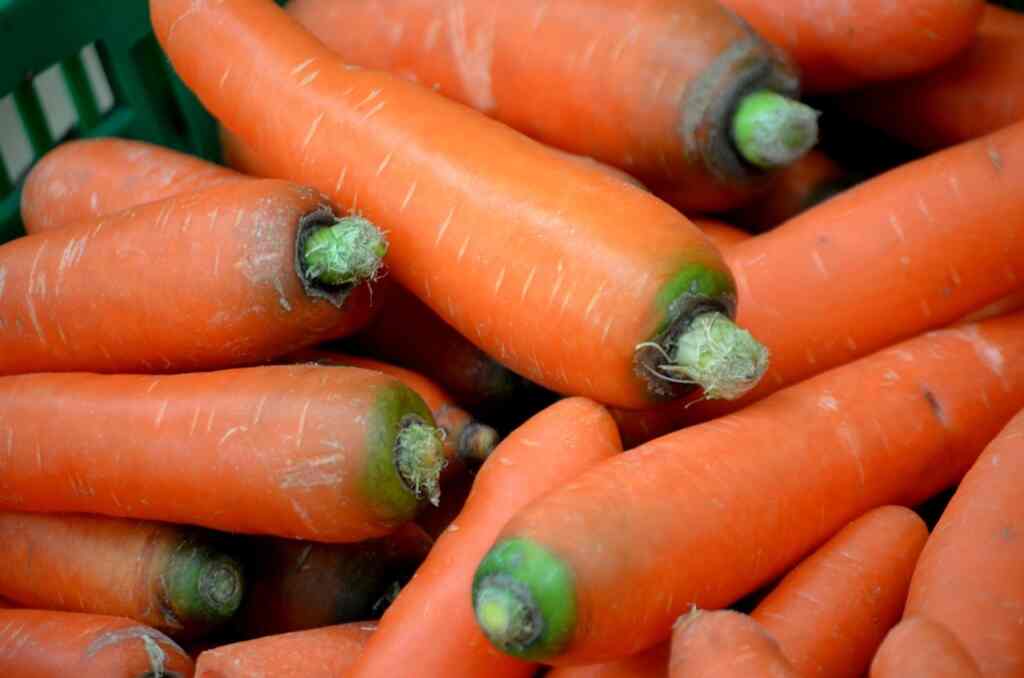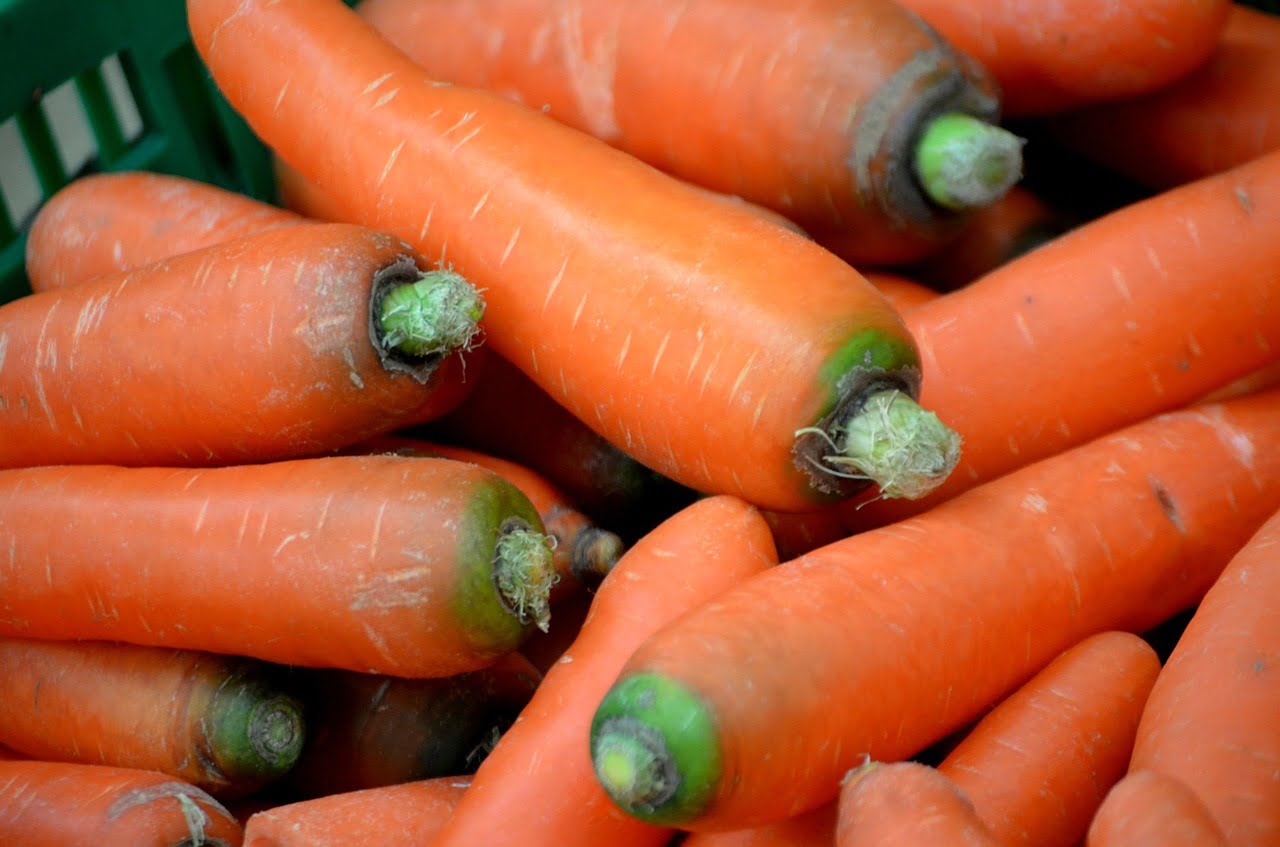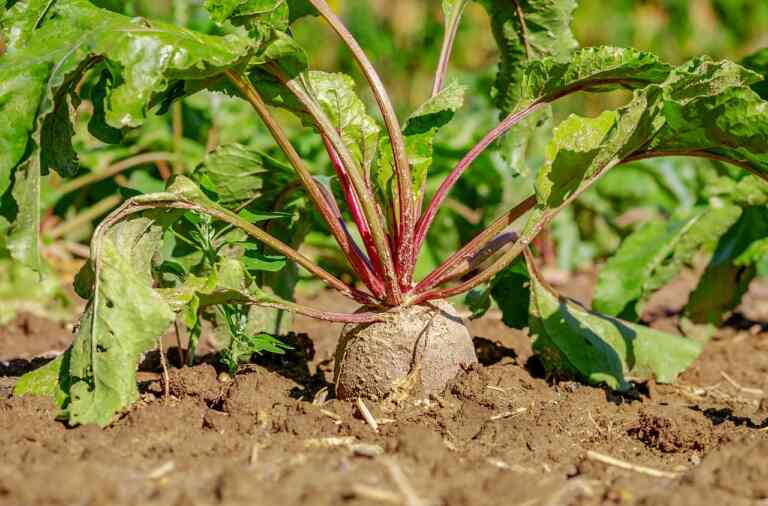Can we eat carrot tops?
Can we eat carrot tops? Yes, carrot tops are edible, and they can be consumed in various culinary preparations. While carrot roots are the more commonly consumed part of the plant, the green leafy tops of carrots are not only safe to eat but can also offer some unique flavor and nutritional benefits. Carrot tops have a slightly earthy and herbaceous taste, which can add depth to your dishes.
When using carrot tops, it’s essential to ensure they are fresh and clean. You can incorporate them into salads, pestos, soups, or use them as a garnish. The tops are rich in vitamins, minerals, and antioxidants, making them a nutritious addition to your diet. However, like any food, it’s important to enjoy carrot tops in moderation and as part of a balanced diet.
Nutritional Value of Carrot Tops
Carrot tops, the leafy greens attached to carrot roots, offer a range of essential nutrients and can be a valuable addition to your diet. Here’s a breakdown of the nutritional value of carrot tops:
- Vitamins:
- Vitamin K: Carrot tops are an excellent source of vitamin K, which plays a crucial role in blood clotting and bone health.
- Vitamin A: They also provide vitamin A in the form of beta-carotene, which supports vision, immune function, and skin health.
- Vitamin C: Carrot tops contain vitamin C, an antioxidant that aids in wound healing, collagen formation, and immune system support.
- Folate: Folate (vitamin B9) in carrot tops is essential for DNA synthesis and cell growth.
- Minerals:
- Calcium: Carrot tops contain calcium, which is vital for bone health, muscle function, and nerve transmission.
- Potassium: Potassium helps maintain proper muscle and nerve function, regulate blood pressure, and balance fluid levels in the body.
- Dietary Fiber:
- Carrot tops are a good source of dietary fiber, which supports digestive health, promotes regular bowel movements, and may help lower cholesterol levels.
- Antioxidants:
- Carrot tops contain various antioxidants, including flavonoids and polyphenols, which help protect cells from oxidative damage caused by free radicals.
- Phytonutrients:
- They may also contain phytonutrients with potential health benefits, such as anti-inflammatory and anti-cancer properties.
- Low in Calories:
- Carrot tops are relatively low in calories, making them a suitable addition to a calorie-conscious diet.
It’s important to note that the nutritional content of carrot tops can vary depending on factors like the carrot variety and growing conditions. However, they are a nutrient-rich and flavorful part of the carrot plant, and when properly prepared, they can provide valuable vitamins, minerals, and antioxidants to your meals.
Benefits of Consuming Carrot Tops
Consuming carrot tops can offer several potential benefits due to their nutritional content and unique flavor. Here are some advantages of including carrot tops in your diet:
- Rich in Vitamins: Carrot tops are an excellent source of various vitamins, including vitamin K, vitamin A (in the form of beta-carotene), vitamin C, and folate. These vitamins play essential roles in supporting various aspects of your health, including vision, immune function, and bone health.
- Mineral Content: They provide minerals like calcium and potassium, which are vital for bone health, muscle function, and maintaining proper blood pressure.
- Antioxidant Protection: Carrot tops contain antioxidants, such as flavonoids and polyphenols, which help protect your cells from oxidative damage caused by free radicals. These antioxidants are associated with reducing the risk of chronic diseases and promoting overall well-being.
- Dietary Fiber: The dietary fiber in carrot tops supports digestive health by promoting regular bowel movements, preventing constipation, and potentially lowering cholesterol levels.
- Low in Calories: Carrot tops are relatively low in calories, making them a suitable addition to a calorie-conscious diet. They can add flavor and nutrition to your meals without significantly increasing calorie intake.
- Flavorful Addition: Carrot tops have a slightly earthy and herbaceous taste, which can add depth and complexity to your dishes. They are especially suitable for use in salads, pestos, soups, and as a garnish.
- Sustainability: Consuming carrot tops reduces food waste, as it utilizes a part of the carrot plant that is often discarded. This sustainable practice aligns with eco-friendly food choices.
- Variety in Your Diet: Including carrot tops in your meals introduces diversity to your diet, offering a range of nutrients and flavors beyond what you typically find in root vegetables.
- Creative Cooking: Experimenting with carrot tops can inspire culinary creativity and expand your repertoire of recipes. They can be used in various dishes to enhance both taste and nutritional value.
Overall, consuming carrot tops can be a delicious and nutritious way to add variety to your diet while benefiting from their vitamins, minerals, antioxidants, and dietary fiber. Just be sure to wash and prepare them properly to maximize their safety and palatability.

Risks and Considerations
While carrot tops offer several nutritional benefits and culinary advantages, there are some risks and considerations to be aware of:
- Pesticide Residues: Carrot tops, like the roots, can potentially contain pesticide residues if the carrots were conventionally grown and treated with pesticides. To minimize this risk, choose organic carrots or wash and scrub carrot tops thoroughly.
- Oxalates: Carrot tops contain oxalates, naturally occurring compounds that can contribute to the formation of kidney stones in susceptible individuals. If you have a history of kidney stones or are at risk, it’s advisable to limit your intake of foods high in oxalates, including carrot tops.
- Allergies: Some individuals may be allergic or sensitive to certain components found in carrot tops. Allergic reactions to carrot tops are rare but possible.
- Texture and Bitterness: Carrot tops have a slightly tough texture and can be somewhat bitter in taste. Some people may find these characteristics less appealing in culinary preparations.
- Moderation: As with any food, it’s important to consume carrot tops in moderation. While they offer nutritional benefits, excessive intake may not be suitable for everyone and could lead to digestive discomfort.
- Proper Preparation: Properly wash and prepare carrot tops before consuming them. Remove any soil, dirt, or contaminants, and consider blanching or cooking them to soften their texture and reduce bitterness if desired.
- Individual Preferences: Carrot tops have a distinctive flavor, and not everyone may enjoy their taste. Whether to include them in your diet is ultimately a matter of personal preference.
- Variety in Diet: While carrot tops can be a valuable addition to your diet, they should not be the sole source of nutrition. Be sure to maintain a balanced diet that includes a variety of foods to ensure you get all the nutrients your body needs.
In summary, while carrot tops are safe to eat and offer nutritional benefits, it’s important to be mindful of potential risks and individual considerations. If you decide to include carrot tops in your diet, do so in moderation and be aware of your specific dietary needs and preferences. Proper washing and preparation can also help ensure their safety and palatability.
Culinary Uses and Recipes with Carrot Tops
Carrot tops are versatile and can be used in various culinary applications to add flavor, nutrition, and a unique twist to your dishes. Here are some culinary uses and recipes with carrot tops:
- Carrot Top Pesto:
- Ingredients: Carrot tops, garlic, nuts (e.g., pine nuts or walnuts), grated Parmesan cheese, olive oil, lemon juice, salt, and pepper.
- Instructions: Blend all ingredients in a food processor until smooth. Use as a sauce for pasta, a spread for sandwiches, or a dip for vegetables.
- Carrot Top Salad:
- Ingredients: Carrot tops, mixed greens, cherry tomatoes, cucumber, red onion, and your choice of salad dressing.
- Instructions: Wash and chop carrot tops and mix them with other salad ingredients. Dress with your favorite salad dressing.
- Carrot Top Soup:
- Ingredients: Carrot tops, carrots, onions, garlic, vegetable broth, potatoes, cream (optional), salt, and pepper.
- Instructions: Sauté onions and garlic, add carrots and potatoes, cook until tender, add carrot tops and vegetable broth, simmer until greens are wilted. Blend until smooth, add cream if desired, and season to taste.
- Carrot Top Chimichurri:
- Ingredients: Carrot tops, garlic, red wine vinegar, olive oil, red pepper flakes, salt, and pepper.
- Instructions: Finely chop carrot tops and garlic, mix with other ingredients. Serve as a condiment for grilled meats or vegetables.
- Stuffed Carrot Tops:
- Ingredients: Carrot tops, ground meat (e.g., beef, lamb, or plant-based alternative), rice, onions, garlic, tomatoes, and spices.
- Instructions: Blanch carrot tops, stuff with a mixture of cooked ground meat, rice, onions, garlic, and tomatoes. Bake until tender.
- Carrot Top Smoothie:
- Ingredients: Carrot tops, spinach or kale, banana, yogurt or dairy-free alternative, honey or agave nectar, and water or juice.
- Instructions: Blend all ingredients until smooth for a nutrient-rich green smoothie.
- Carrot Top Garnish: Use carrot tops as a decorative garnish for various dishes, such as soups, salads, or roasted vegetables, to add a pop of color and a hint of carrot flavor.
- Carrot Top Chips: Toss carrot tops with olive oil and seasonings, then bake in the oven until they become crispy. Use them as a garnish or a crunchy snack.
- Carrot Top Tabbouleh: Replace traditional parsley with finely chopped carrot tops in a classic tabbouleh salad for a unique twist on this Middle Eastern dish.
- Carrot Top Hummus: Blend carrot tops into homemade hummus for a vibrant green dip.
When using carrot tops in your recipes, it’s important to wash them thoroughly, remove any tough stems, and use only the tender leafy greens. Remember that the flavor of carrot tops is slightly herbaceous and earthy, so they pair well with a variety of ingredients and cuisines, providing a fresh and nutritious component to your meals.
How to Prepare Carrot Tops for Consumption
Properly preparing carrot tops for consumption involves a few simple steps to ensure they are clean, safe to eat, and palatable. Here’s how to prepare carrot tops:
Ingredients:
- Fresh carrot tops
Instructions:
- Harvest or Purchase Fresh Carrot Tops: Harvest carrot tops from freshly picked carrots or purchase them from a reputable source. Ensure that they are free from signs of wilting or spoilage.
- Separate the Tops: Carefully separate the carrot tops from the carrot roots. Grasp the tops near the base and gently pull them away from the roots.
- Wash Thoroughly: Under cold running water, wash the carrot tops to remove any dirt, sand, or contaminants. Gently rub the leaves with your fingers to ensure thorough cleaning.
- Trim the Stems: Examine the carrot tops and trim any tough or woody stems. The tender leafy greens are the most desirable part for consumption.
- Blanching (Optional): To reduce bitterness and soften the texture of carrot tops, you can blanch them. Bring a pot of water to a boil and briefly submerge the carrot tops (about 30 seconds to 1 minute). Immediately transfer them to a bowl of ice water to stop the cooking process. Drain well.
Frequently Asked Questions About Eating Carrot Tops
Here are some frequently asked questions (FAQs) about eating carrot tops, along with their answers:
1. Are carrot tops safe to eat?
- Yes, carrot tops are safe to eat. They are not toxic and can be consumed when properly prepared.
2. Can I eat carrot tops raw?
- Yes, you can eat carrot tops raw, and they can add a fresh and slightly earthy flavor to your dishes. However, some people prefer to blanch or cook them briefly to reduce bitterness and soften the texture.
3. How do I remove bitterness from carrot tops?
- Blanching carrot tops in boiling water for about 30 seconds to 1 minute can help reduce bitterness. Immediately transfer them to ice water to stop the cooking process.
4. Can I use carrot tops in smoothies?
- Yes, you can use carrot tops in smoothies. They add a nutrient-rich, green element to your smoothie and can be blended with other fruits and vegetables.
5. Do carrot tops taste like carrots?
- Carrot tops have a slightly different flavor than carrots. They are slightly herbaceous and earthy with a hint of carrot flavor. The taste is often described as fresh and mildly bitter.
6. Are there any health benefits to eating carrot tops?
- Yes, carrot tops are nutritious and offer vitamins (such as vitamin K, vitamin A, and vitamin C), minerals (including calcium and potassium), antioxidants, and dietary fiber. They can support overall health and well-being when included in a balanced diet.
Conclusion: Making Informed Choices Regarding Carrot Tops in Your Diet
In conclusion, making informed choices regarding the inclusion of carrot tops in your diet involves understanding their safety, flavor, nutritional benefits, and culinary versatility. Carrot tops are safe to eat and can be a valuable addition to your meals when properly prepared.
Key points to consider when it comes to carrot tops in your diet:
- Nutritional Value: Carrot tops are rich in vitamins (such as vitamin K, vitamin A, and vitamin C), minerals (including calcium and potassium), antioxidants, and dietary fiber. They offer various health benefits.
- Flavor Profile: Carrot tops have a slightly herbaceous and earthy flavor with a hint of carrot taste. This unique taste can enhance the flavor of a wide range of dishes.
- Culinary Versatility: Carrot tops can be used in various culinary applications, including salads, soups, pestos, garnishes, and more. They provide a creative and nutritious element to your cooking.
- Safety: Carrot tops are safe to eat when properly washed and prepared. Removing any tough stems and potentially blanching them can improve their texture and reduce bitterness.
- Moderation: As with any food, it’s important to consume carrot tops in moderation and as part of a balanced diet. Incorporate them alongside other nutritious foods.
- Variety: Including carrot tops in your diet can add variety to your meals and help reduce food waste, as it utilizes a part of the carrot plant that is often discarded.
Ultimately, the decision to include carrot tops in your diet is a matter of personal preference and culinary experimentation. By understanding their potential benefits and following proper preparation techniques, you can enjoy the flavor and nutrition that carrot tops bring to your meals, contributing to a well-rounded and diverse diet.
Related Posts
This article is reviewed by Russel, before publishing. If you have any doubt, you can contact us or consult with your nearby doctor. Remember, in medical matters, there is no same advice, cure, and medicine for all.







